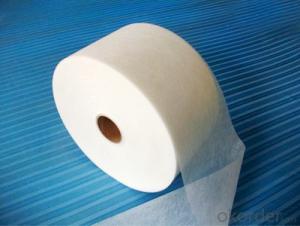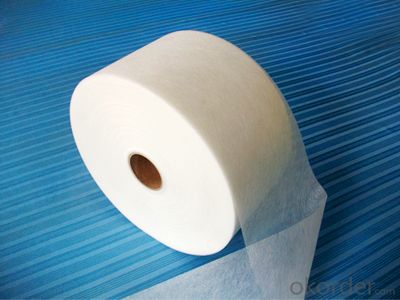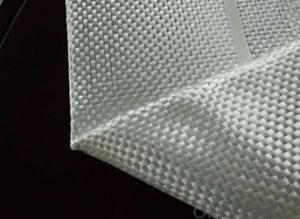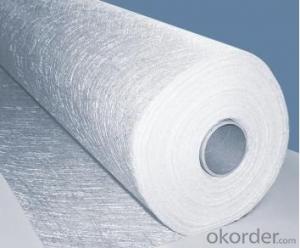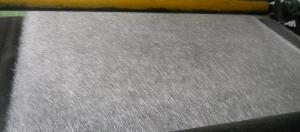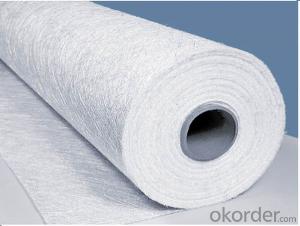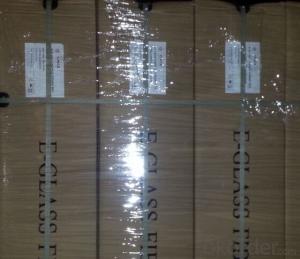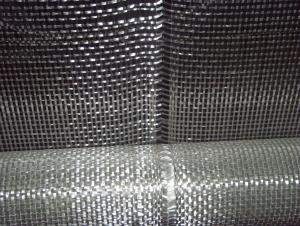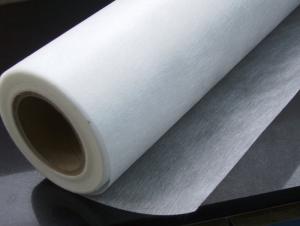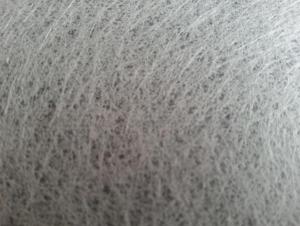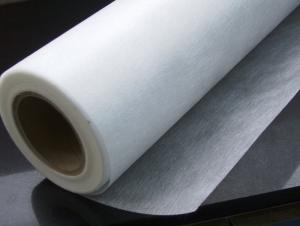Glass Fiber Surface Tissue For FRP Industry
OKorder Service Pledge
OKorder Financial Service
You Might Also Like
Descrition:
Fiberglass surface mat is mainly used for the surface layer of fiberglass products. Divided into specific wound type S-BM (w) series, hand lay-type S-BM (H) series and pultrusion type S-BM (P) series of three categories.
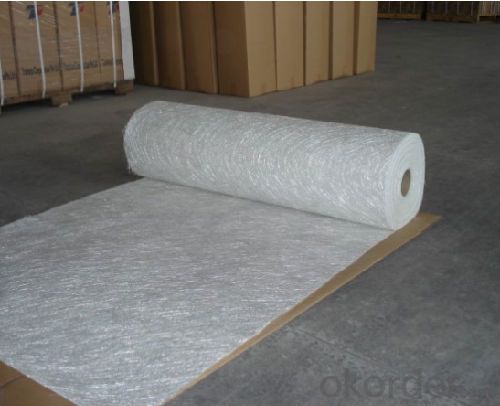
Main features:
1, fibers uniformly dispersed
2, resin-impregnated fast
3-volt mode is good
4, to cover wove, smooth surface layer
5, anti-aging, good corrosion resistance

Specificaiton
| Product Code | Unit Weight(g/㎡) | Gum content(%) | Longitudinal tensile strength(N/5cm) | Moisture content(%) |
| S-BM(W)-30 | 30 | 7 | ≥30 | ≤0.5 |
| S-BM(W)-50 | 50 | 7 | ≥50 | ≤0.5 |
| S-BM(H)-30 | 30 | 6 | ≥25 | ≤0.5 |
| S-BM(H)-50 | 50 | 6 | ≥40 | ≤0.5 |
| S-BM(P)-90 | 90 | 8 | ≥200 | ≤0.5 |
Packaging:
The mat roll is wrapped up with plastic film,and then packed in a cardboard box or wrapped up with kraft paper. The rolls can be horizontally placed. For transportation, the rolls can be loaded into a cantainer directly or on pallets.

- Q: Is fiberglass mat tissue resistant to earthquakes?
- Fiberglass mat tissue does not possess specific earthquake resistance capabilities. Its primary purpose lies in the construction industry, where it reinforces and strengthens various surfaces like walls, floors, and ceilings. Although fiberglass can offer some level of structural stability, it is not specifically engineered to endure the intense shaking and ground motion induced by earthquakes. To establish earthquake resistance in a structure, engineers usually utilize a combination of methods and materials. These include reinforced concrete, steel frameworks, and specialized seismic design principles. These measures specifically target the dissipation and absorption of energy generated during an earthquake, ensuring the building's structural integrity and the safety of its occupants. Therefore, if you seek earthquake resistance in a building or structure, it is crucial to seek guidance from a professional engineer specializing in seismic design. They can provide expert recommendations on suitable materials and construction techniques.
- Q: How is fiberglass mat tissue used in the manufacturing of wind turbine blades?
- Fiberglass mat tissue is extensively used in the manufacturing of wind turbine blades due to its exceptional strength, durability, and lightweight properties. It serves as a critical reinforcement material that enhances the structural integrity and performance of the blades. During the manufacturing process, layers of fiberglass mat tissue are carefully placed and bonded together to form the composite structure of the wind turbine blade. The tissue layers are typically impregnated with a resin, such as epoxy or polyester, to create a strong and rigid matrix. The use of fiberglass mat tissue allows for the creation of complex blade shapes with high dimensional accuracy. It provides excellent resistance against various environmental factors, such as UV radiation, moisture, and temperature fluctuations, ensuring the longevity of the turbine blades in harsh weather conditions. The mat tissue also plays a crucial role in distributing and absorbing the loads experienced by the wind turbine blades. It enhances the overall strength and stiffness of the structure, allowing the blades to withstand the aerodynamic forces exerted by the wind. This reinforcement is particularly important to prevent blade deformation and fatigue, ensuring optimal performance and safety over the lifetime of the turbine. Moreover, the lightweight nature of fiberglass mat tissue contributes to the efficiency of wind turbine blades. The reduced weight of the composite structure enables the blades to rotate more easily and capture more energy from the wind. This, in turn, increases the power output and efficiency of the wind turbine system. Overall, fiberglass mat tissue is a fundamental component in the manufacturing of wind turbine blades, providing essential reinforcement, durability, and lightweight properties. Its use significantly contributes to the performance, reliability, and sustainability of wind energy generation.
- Q: Can fiberglass mat tissue be used for windbreak panels?
- Windbreak panels can utilize fiberglass mat tissue, which functions as a lightweight and flexible material. This material is commonly utilized in insulation, reinforcement, and structural support applications. It is recognized for its durability, high strength-to-weight ratio, and ability to withstand various weather and environmental conditions. By incorporating fiberglass mat tissue into windbreak panels, additional reinforcement and stability are provided. This reinforcement allows the panels to endure strong winds without experiencing damage or breakage, rendering fiberglass mat tissue an effective choice for windbreak panels. Furthermore, fiberglass mat tissue possesses exceptional thermal and acoustic insulation properties. This feature contributes to the reduction of noise and regulation of temperature within windbreak panels, thus creating a more comfortable and protected environment. Additionally, this material is fire-resistant, ensuring the safety of windbreak panels. In summary, considering its strength, durability, insulation properties, and resistance to environmental conditions, fiberglass mat tissue proves to be a suitable and dependable material for windbreak panels.
- Q: What is the UV resistance of fiberglass mat tissue?
- The UV resistance of fiberglass mat tissue may vary depending on the specific formulation and manufacturing process employed. Generally, fiberglass mat tissue is renowned for its outstanding ability to withstand ultraviolet (UV) radiation. The mat's fiberglass strands typically receive a coating of resin or binder, which affords additional safeguard against UV degradation. This coating acts as a barrier, preventing the fibers from deteriorating or becoming brittle under sunlight exposure. Moreover, the dense and tightly woven construction of the fiberglass mat tissue itself grants a certain level of inherent UV resistance. Nonetheless, it is crucial to note that extensive exposure to intense UV radiation can still result in some degree of deterioration over time. As such, it is advisable to refer to the specific product specifications or manufacturer's guidelines for precise information regarding the UV resistance of a particular fiberglass mat tissue.
- Q: Can fiberglass mat tissue be used for making insulation jackets?
- Yes, fiberglass mat tissue can be used for making insulation jackets. Fiberglass mat tissue is a versatile material that is commonly used in various insulation applications due to its excellent thermal insulation properties. It is lightweight, flexible, and provides effective insulation against heat transfer. When used in insulation jackets, fiberglass mat tissue can help to retain heat and prevent heat loss, making it an ideal choice for applications where thermal insulation is required. Additionally, fiberglass mat tissue is also fire-resistant, which further enhances its suitability for insulation jackets.
- Q: What is the expected lifespan of fiberglass mat tissue in chemical storage applications?
- The expected lifespan of fiberglass mat tissue in chemical storage applications can vary depending on several factors. These factors include the type of chemicals being stored, the concentration of the chemicals, and the specific conditions of the storage environment. Fiberglass mat tissue is commonly used in chemical storage applications due to its excellent resistance to corrosion and its ability to provide structural reinforcement. However, it is important to note that fiberglass mat tissue is not completely impervious to chemical degradation. In general, fiberglass mat tissue can withstand a wide range of chemicals and can have a relatively long lifespan when properly maintained. It is typically designed to last for several years, with some manufacturers offering warranties ranging from 10 to 20 years. However, certain aggressive chemicals or extreme storage conditions may accelerate the degradation process of fiberglass mat tissue. Chemicals with high acidity or alkalinity, extreme temperatures, or prolonged exposure to UV radiation can potentially reduce the lifespan of the material. To ensure the maximum lifespan of fiberglass mat tissue in chemical storage applications, it is essential to carefully select the appropriate type of fiberglass mat tissue that is specifically designed for the intended chemicals and storage conditions. Regular inspections, maintenance, and proper handling of the chemicals can also help extend the lifespan of the material. Ultimately, it is recommended to consult with the manufacturer or a qualified engineer to determine the expected lifespan of fiberglass mat tissue in a specific chemical storage application, as they can provide more accurate information based on the specific circumstances.
- Q: Does fiberglass mat tissue require any special tools for installation?
- Yes, fiberglass mat tissue may require some special tools for installation. These tools can include a utility knife or scissors for cutting the mat to the desired size, a roller or brush for applying adhesive or resin to secure the mat to the desired surface, and safety equipment such as gloves and goggles to protect the installer from potential hazards. Additionally, some installations may require the use of a heat gun or torch to activate or cure the resin. It is important to read and follow the manufacturer's instructions and recommendations for the specific fiberglass mat tissue being used to ensure proper installation and to determine if any special tools are required.
- Q: Does fiberglass mat tissue provide good thermal conductivity?
- Fiberglass mat tissue, unfortunately, does not possess commendable thermal conductivity. The insulating properties of fiberglass are widely recognized, as it serves as an inadequate conductor of heat. Its thermal conductivity is low, resulting in ineffective heat transfer. As a consequence, fiberglass mat tissue is an appropriate choice for insulation purposes, particularly in scenarios where minimizing heat transfer is essential, like in building insulation or the production of heat-resistant garments.
- Q: Can fiberglass mat tissue be used for making lightweight stairs?
- Yes, fiberglass mat tissue can be used for making lightweight stairs. Fiberglass mat tissue is a lightweight and strong material that can be easily molded into various shapes, including stairs. It offers excellent strength-to-weight ratio, making it ideal for constructing lightweight structures such as stairs. Additionally, fiberglass is durable, corrosion-resistant, and non-conductive, making it a suitable choice for stairs that need to withstand heavy use and harsh environmental conditions.
- Q: What is the shear strength of fiberglass mat tissue?
- The shear strength of fiberglass mat tissue can vary depending on various factors such as the specific type of fiberglass mat tissue, its thickness, and the manufacturing process. However, in general, fiberglass mat tissue typically has a relatively high shear strength due to the inherent strength and rigidity of fiberglass materials.
Send your message to us
Glass Fiber Surface Tissue For FRP Industry
OKorder Service Pledge
OKorder Financial Service
Similar products
Hot products
Hot Searches
Related keywords
